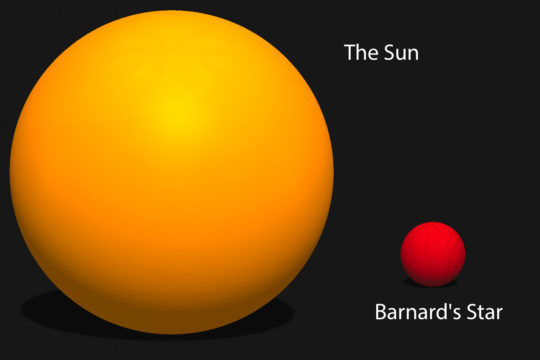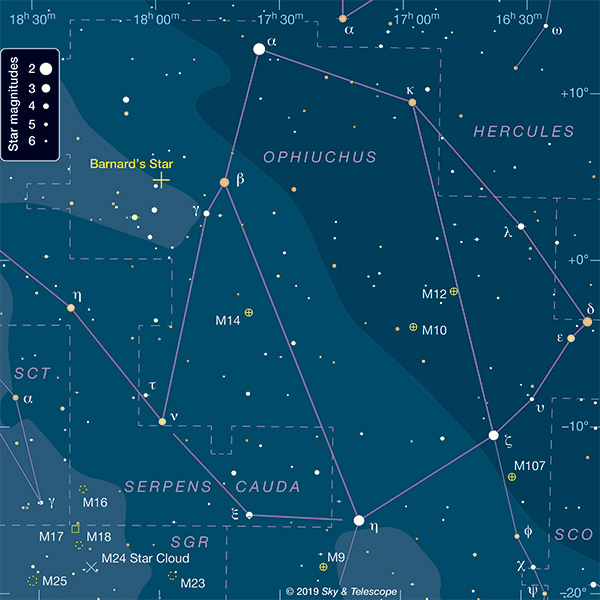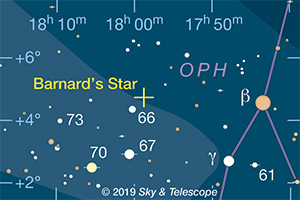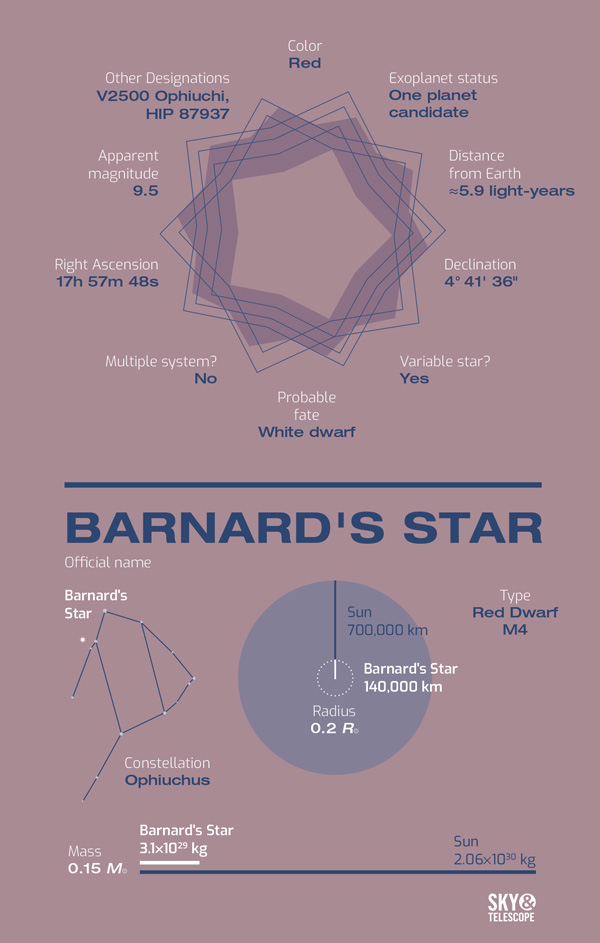The Vitals
Physical Characteristics
So far in this series, we’ve examined bright stars easily seen without optical aid. Naturally, these stars tend to be large and luminous. But now we turn to a star that is not nearly so bright, smaller than the Sun, and much closer to home — but no less interesting. We’re talking about Barnard’s Star.
Barnard’s Star is a red dwarf, a small star only 1/5 the radius of the Sun. It’s only a little bigger than Jupiter in diameter, but much denser — Barnard’s Star has about 15% of the Sun’s mass, the equivalent of 160 Jupiters.
The Alpha Centauri system represents the nearest stellar neighbor to our Sun, just more than four light-years away. Barnard’s Star, on the other hand, is only slightly farther away, at about six light-years distant. Its proximity has made Barnard’s Star a thoroughly studied star. Yet, unlike the brilliant Sirius, proximity to Barnard’s Star doesn’t translate into easy visibility. Because the star is a red dwarf with low luminosity — it puts out only about 1/2,600 as much light as the Sun — we see it at 9th magnitude, so it requires a telescope to view.

Daniel Johnson
Barnard’s Star is most notable for its rapid proper motion, tearing across the sky at a surprising 10.3 arcseconds each year — the fastest proper motion of any measured star. Naturally, a contributor to this apparent motion is the star’s close range, but Barnard’s Star actually is on the move as well, traveling about 140 kilometers per second (300,000 mph) in our direction.
Barnard’s Star is also the home of a recently discovered exoplanet candidate — a so-called “super-Earth” that has perhaps three times the mass of our planet. However, this isn’t the first time that astronomers have claimed to find an exoplanet around Barnard’s Star. One or more gas giants were suspected during the 1960s and 70s, only to be disputed in subsequent decades.
Origin / Mythology
Because Barnard’s Star requires a telescope to be seen, it was unknown to our distant ancestors who might have otherwise decorated the star with the types of traditional stories so common to the bright stars of the night sky. Indeed, Barnard’s Star wasn’t discovered until 1916, although it was later found to have appeared in photographic plates as early as 1888. The astronomer Edward Barnard — the star’s namesake — was the first to recognize Barnard’s Star for what it is: a nearby red dwarf with an exceptionally rapid proper motion.
But even though you won’t find Barnard’s Star woven into the cultures of the ancients, modern society has, in a way, created its own form of “mythology” for the star. In the 1970s, the British Interplanetary Society used Barnard’s Star as the destination of its Daedalus project. The study investigated — only on paper, of course — the possibility of sending an unmanned interstellar probe to a star within a human lifetime. While the Daedalus study took the liberty of assuming the existence of a fusion engine (not to mention fuel tanks far beyond the size of any craft ever built), the study nevertheless found that the concept of an interstellar flyby probe was possible — at least in theory. Barnard’s Star was selected as the destination for the study in part because of its then-suspected exoplanets.
How to See Barnard’s Star
Ready for a challenge? Locating Barnard’s Star with your telescope is a task that requires good optics and some practice with star-hopping. A detailed star map of Ophiuchus is also needed, as you’ll need to work your way to Barnard’s Star by using other, brighter stars as guides (a GoTo mount, of course, will make short work of this challenge).

Sky & Telescope
Generally, summer is a fine time to go searching for Barnard’s Star in the Northern Hemisphere, as Ophiuchus rides high in the sky during that time of year. However, it's visible closer to the evening horizon well into the autumn. You can imagine the location of Barnard’s Star as the fourth member of the Summer Triangle, turning it into something of a Summer Quadrilateral (a name that surely won’t catch on!). Barnard’s Star isn’t far from the much brighter Rasalhague.

Sky & Telescope
If you’re a fan of astrophotography and are looking for a long-term project, photographing the gradual proper motion of this star is something that an amateur can realistically achieve. It’s similar to photographing the motion of an asteroid or comet, although the process is much slower. Over the course of a few years, you would be able to stitch together a composite image showing Barnard’s Star traveling slowly against a background of more distant stars.
 2
2










Comments
Joe Stieber
September 10, 2019 at 12:06 pm
As a regular observer of Barnard’s Star, I particularly enjoyed this article, especially the background information about the star itself. Indeed, it is probably under-observed by amateur astronomers in general.
As far as spotting it goes, a scope is not a necessity as I spot it regularly using my handheld 15x56 binoculars, albeit, that would be from a dark site. At magnitude 9.5, it’s not a significant challenge for almost any decent scope. However, it requires that one knows exactly where it is, since besides a tinge of reddish color, it looks like just another star in the field of view. With my alt-azimuth telescopes, I quickly find it manually using just a reflex finder projecting a bullseye on the sky.
The charts in the article provide a fine overview of its location in northeast Ophiuchus, although I suspect Ophiuchus is just a vague patch of sky to many observers. For finding Barnard’s Star, I narrow my attention to Cebalrai (Beta Oph), and 4° east of it, 66 Oph. Barnard’s Star is about three-quarters of a degree west of 66 Oph. I’m surprised you didn’t mention the nearby group of stars with which 66 Oph is associated, a V-shaped asterism (66, 67, 68,70 & 73 Oph) which represents the obsolete constellation, Taurus Poniatovii. It has a resemblance to the V-shape of the Hyades.
At this point, as you suggest in the article, one needs a good star chart to pinpoint Barnard’s Star. I would add that it’s needed even if using “go-to” to reach the nominal spot. The chart in a paper atlas should have a line marked with dates for the position of Barnard’s Star, like chart A1 in SkyAtlas 2000, which has tick marks at the years 1900, 2000 and 2100. Many software sky charts calculate the position for the date selected, but not all.
In May 2017, I took a snapshot of the respective area showing Barnard’s Star. It’s at….
http://sjastro.org/barnard-star.htm
Keep in mind my image is a simple single-frame snapshot using a fixed tripod, so it’s not a fine astrophoto, but it does show Barnard’s Star and the field stars around it, as well as screen clips from SkyTools and SkySafari showing the different positions they indicate in 2017 when I took the picture (it was SkySafari 5, but version 6 shows the same). SkyTools had the current position, SkySafari was fixed at the 2000 position. The 10.3 arc seconds/year movement amounts to about 3 arc minutes after 17 years, which may not seem like much, but in a magnified eyepiece view, it won’t match up.
You must be logged in to post a comment.
Daniel_Johnson
September 15, 2019 at 2:03 pm
Thanks for sharing your observations, Joe. I think you're correct that part of the challenge of viewing Barnard's Star lies in the fact that Ophiuchus perhaps isn't as well-known or familiar as some of the other, more impressive constellations.
You must be logged in to post a comment.
You must be logged in to post a comment.